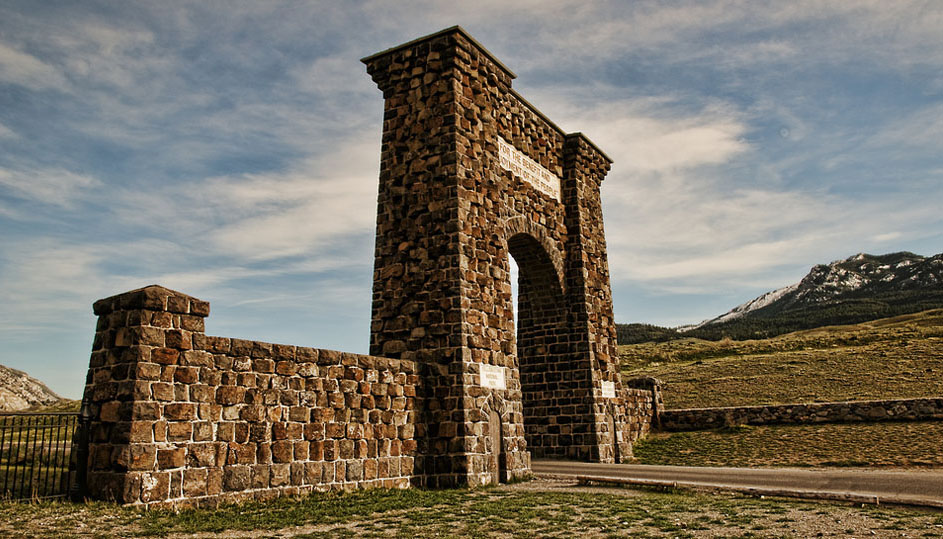
By Ruffin Prevost
The last best place. Like no other place on earth. The trip of a lifetime. The place where hell bubbled up. America’s best idea. Wonderland.
Yellowstone National Park is all those things and more.
Together with adjacent Grand Teton National Park, Yellowstone has made indelible impressions on everyone from lone 19th-century fur trappers to busloads of 21st-century tourists.
To those of us lucky enough to live in Yellowstone Country, it’s a backyard wonderland that never fails to delight and amaze, educate and enlighten, awe and inspire. It’s also an economic, natural and social dynamo that shapes commerce, ecology and the daily lives of everyone inside and around its borders — all while serving as an icon and symbol of wild wonder for the nation and the world.
Which is the reason for Yellowstone Gate.

For a local reporter, there is no more compelling story or important dynamic than the relationship between Yellowstone and Grand Teton national parks, their wildlife and the people living and working across the region. Each year, up to 3.5 million visitors spend their hard-earned money and precious vacation days to get a glimpse of what gateway community residents can experience every day. Their dollars drive the local economies. The wildlife and their habitat attract the visitors. The residents serve the needs and wants of the visitors. And those charged with managing the parks and surrounding public lands must balance it all.
A new approach
News coverage in and around the parks is expensive and time-consuming. National media outlets drop in for big, splashy stories like fires or bear attacks — or they offer the occasional travel or environmental feature. Local reporters understandably focus on the hot-button issues that are most important in their communities. But much of the coverage from all sources breaks down along state or county lines — or it follows a narrow, single-issue approach that too often produces a fragmented and polarized result.
It’s time for a new approach.
Yellowstone Gate aims to adopt a holistic approach to reporting on the common issues affecting the parks and their gateway communities.
People in Cooke City, Mont. should know what common issues are making waves in West Yellowstone, Mont. Life at park headquarters in Mammoth, Wyo. and Moose, Wyo. is about more than uniforms and regulations. Cody, Wyo. and Gardiner, Mont. have more in common than their residents might think. And Jackson, Wyo., a town that more closely resembles the demographics of Palm Beach, Fla., is bound to its neighboring gateway towns by the same parks that separate them. It’s time for a news coverage model that reflects these unheralded commonalities.
The plants and animals of Yellowstone Country, of course, know no boundaries. Their interconnected ecology is shaped by local and regional businesses, resident and visitor recreational activities, millions of annual tourists and a host of local, state and federal management agencies that don’t always agree on how to balance the competing interests tugging at the fragile fabric of natural and social ecosystems.
The role of Yellowstone Gate is not to solve — or even define or circumscribe — the vast challenges and opportunities that come with living in Yellowstone Country. Rather, it is to celebrate the endless virtues of calling this place home.

But Yellowstone Gate also exists to act as an impartial watchdog of the public interest. Its mission includes focusing on how we care for our public lands, operate our travel and tourism industry, manage our wildlife and plan for our common future.
Self-nominated
The parks and their gateway communities are too important not to have an active corps of experienced, local reporters covering them as a dedicated beat. Which explains how I got this job — by nominating myself.
I cover Yellowstone and Grand Teton parks and Wyoming for Reuters, the world’s largest international multimedia news agency. From 2005-2010, I covered the same beat for The Billings Gazette, the largest daily newspaper in the region. Most recently, I was managing editor of WyoFile, a small, statewide nonprofit news service focused on Wyoming people, places and policy. But in all of those jobs, I never got into the parks as much as I wanted, as either a reporter or a “civilian.”
So I established Yellowstone Gate to serve what I think is a growing need for local news about life in and around the parks — as well as for the obviously selfish reason of enjoying one of the best jobs I could hope to create for myself.
I approach the task with no political agenda, defining worldview or partisan belief system. I pledge to do my best to present news without bias or favoritism, and to be accurate and fair and complete in my reporting — while demanding the same of those who write for Yellowstone Gate. I hope you’ll let me know how you think we’re doing.
Thanks for stopping by, and please check back often in the weeks ahead as we post new stories, develop new content and work to build an engaging online community that is focused on the overriding common interests we share as residents of this unique and special place.
Ruffin Prevost, editor
Yellowstone Gate
Cody, Wyo.
11/11/11
Contact Ruffin Prevost at [email protected] or 307-213-9818.

Excellent! Good to see it.
That a boy Luther. Very nice touch, Ruffin.
Enjoyable reading, wonderful format, great to see up to date news from Yellowstone Gateway communities